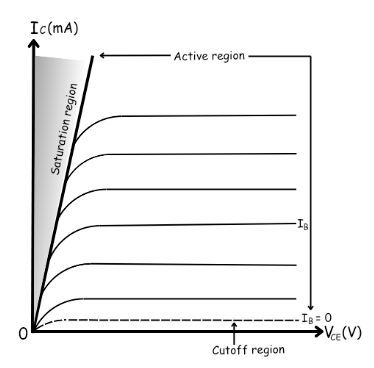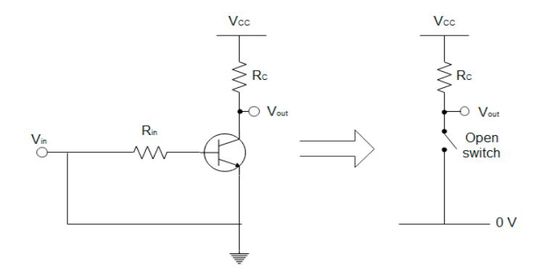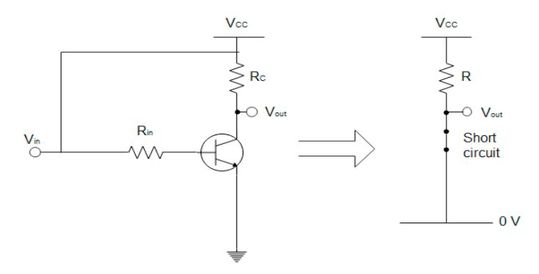TRANSISTOR TECHNOLOGY How to use a transistor as a switch?
Related Vendors
One of the applications of a BJT transistor is to perform switching functions. Operating a BJT in cut-off and saturation regions enables it to perform switching in various applications. The switch logically turns “ON” and “OFF” during its operations with less power dissipation. The article explains the operation of an NPN BJT in a common-emitter configuration as a switch.

When is it useful to use a transistor as a switch?
A BJT (Bipolar Junction Transistor) performs switching operations in cut-off and saturation regions.
Operating modes of an NPN BJT in CE configuration:
| Base-emitter junction | Base-collector junction | Mode | Operation |
| Forward Bias | Reverse Bias | Forward Active | Amplifier |
| Forward Bias | Forward Bias | Saturation | Closed switch Fully ON |
| Reverse Bias | Reverse Bias | Cut-off | Open switch Fully OFF |
| Forward Bias | Reverse Bias | Reverse Active | Inactive operation (Rarely used) |
The output characteristics of a common emitter configuration are plotted for output collector current IC at the Y-axis vs output voltage VCE at the X-axis for different values base current IB.

These characteristics define the cut-off and saturation regions where the transistor is turned off and on. A Transistor should provide negligible power losses during the switching operations.
A transistor is used as a switch in LEDs, lamps, motors, relays, etc.
How does a transistor work as a switch?
Open switch
Transistor operates as an open switch in the cut-off region when base-emitter and base-emitter junctions are reverse-biased. The input voltage is lesser than 0.7 V (Threshold voltage for Si-NPN Transistor), making the base current IB zero. It is because the width of the depletion layer increases to forbid charge carrier movement inside the device. However, a small reverse leakage current flows due to minority charge carriers.
The transistor acts as an open switch in the cut-off or inactive region and is considered logically “OFF”. We can open-circuit the transistor region.

In the cut-off region, the base current IB is zero, and the collector current IC has a less value (negligible). Hence, the power loss is minimum during the cut-off mode.
Short circuit
Transistor operates as a closed switch in the saturation region when base-emitter and collector-base junctions are forward-biased. The width of the depletion region reduces and the maximum current termed ICSAT flows through the circuit.
The transistor acts as a short circuit or closed switch and is considered logically “ON”. We can short-circuit the transistor region.

In the saturation region, collector-emitter voltage VCE has a very less value (negligible) for the operation. Hence, the power loss is minimum during the saturation mode.
What are the advantages of using a transistor as a switch?
There are many advantages of using a transistor as a switch.
- 1. Less Power Dissipation: The transistor provides less power dissipation in cut-off and saturation regions compared to other devices.
- 2. Safe Operation: Transistor performs safely in low voltages.
- 3. Transistors run on electrical inputs compared to mechanical switches. The problems of moving parts, rear-tear, and replacement are eliminated.
- 4. Lesser size and weight.
- 5. Transistor switches can operate for high-current applications.
- 6. BJT switches have lower conduction losses compared to the power MOSFET.
(ID:49432133)




:quality(80)/p7i.vogel.de/wcms/f1/de/f1de0c5e59f67aa7f2572932ec1f4be9/0118079617.jpeg)
:quality(80)/p7i.vogel.de/wcms/87/7b/877b3ce1be09eb309e4e952ddeed5f76/0118162459.jpeg)
:quality(80)/p7i.vogel.de/wcms/53/fb/53fb719e1b7ca51e26a600beb4973caa/0117927695.jpeg)
:quality(80)/p7i.vogel.de/wcms/20/5f/205f55e131397019d7d0b4c93afd7692/0117866888.jpeg)
:quality(80)/p7i.vogel.de/wcms/c1/f2/c1f297688969aa72399076f01dda34bb/0118112747.jpeg)
:quality(80)/p7i.vogel.de/wcms/13/e3/13e3bfa7ebef959901dc5cbf86be46e5/0118079609.jpeg)
:quality(80)/p7i.vogel.de/wcms/9b/f4/9bf4c897c21cec0c927124f0b716f48d/0117966730.jpeg)
:quality(80)/p7i.vogel.de/wcms/da/ff/daff35bdf441484576a996352b0b8b5e/0117868043.jpeg)
:quality(80)/p7i.vogel.de/wcms/08/4b/084bdffffea262d1988a4a9092ac74a6/0118170678.jpeg)
:quality(80)/p7i.vogel.de/wcms/df/6d/df6d4da46e35064efa91d9b8658131a0/0118004183.jpeg)
:quality(80)/p7i.vogel.de/wcms/3e/9e/3e9ed788776623d655ec51f92e151ef4/0117774205.jpeg)
:quality(80)/p7i.vogel.de/wcms/35/f2/35f243dd4bd4d57587bd7e4f7a85d6fa/0117752002.jpeg)
:quality(80)/p7i.vogel.de/wcms/a0/22/a0220573ab4987d56f248dd3d9712760/0117238956.jpeg)
:quality(80)/p7i.vogel.de/wcms/4e/13/4e1363ce48fc85e61d98a235969d4638/0116922802.jpeg)
:quality(80)/p7i.vogel.de/wcms/70/14/7014ecedef4954eb2b455e5a522804b7/0102877609.jpeg)
:quality(80)/p7i.vogel.de/wcms/8d/a5/8da5b7876ca5418c7a6666a4b6fe01ed/0116529715.jpeg)
:fill(fff,0)/p7i.vogel.de/companies/63/c7/63c7da97be945/diotec.png)
:fill(fff,0)/p7i.vogel.de/companies/60/7e/607ec89d5d9b5/white-frame.jpg)
:fill(fff,0)/p7i.vogel.de/companies/63/c5/63c570e9838ca/logo-we-mtye-rgb-pos.png)
:quality(80)/p7i.vogel.de/wcms/f8/20/f8200c20833f88f20ef5ba0f85550259/0110796538.jpeg)
:quality(80)/p7i.vogel.de/wcms/34/24/34243ab470fd7bcd3cfd4a7564c2b4eb/0111077180.jpeg)